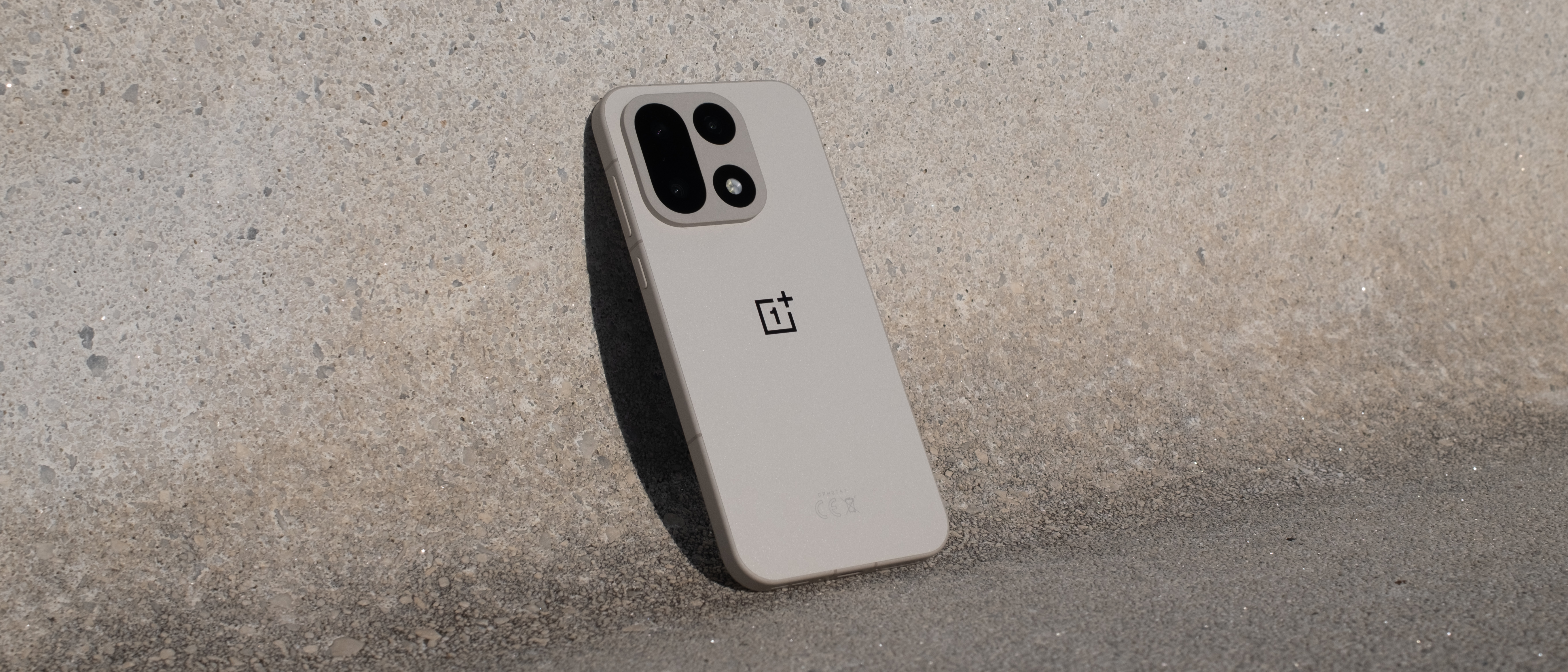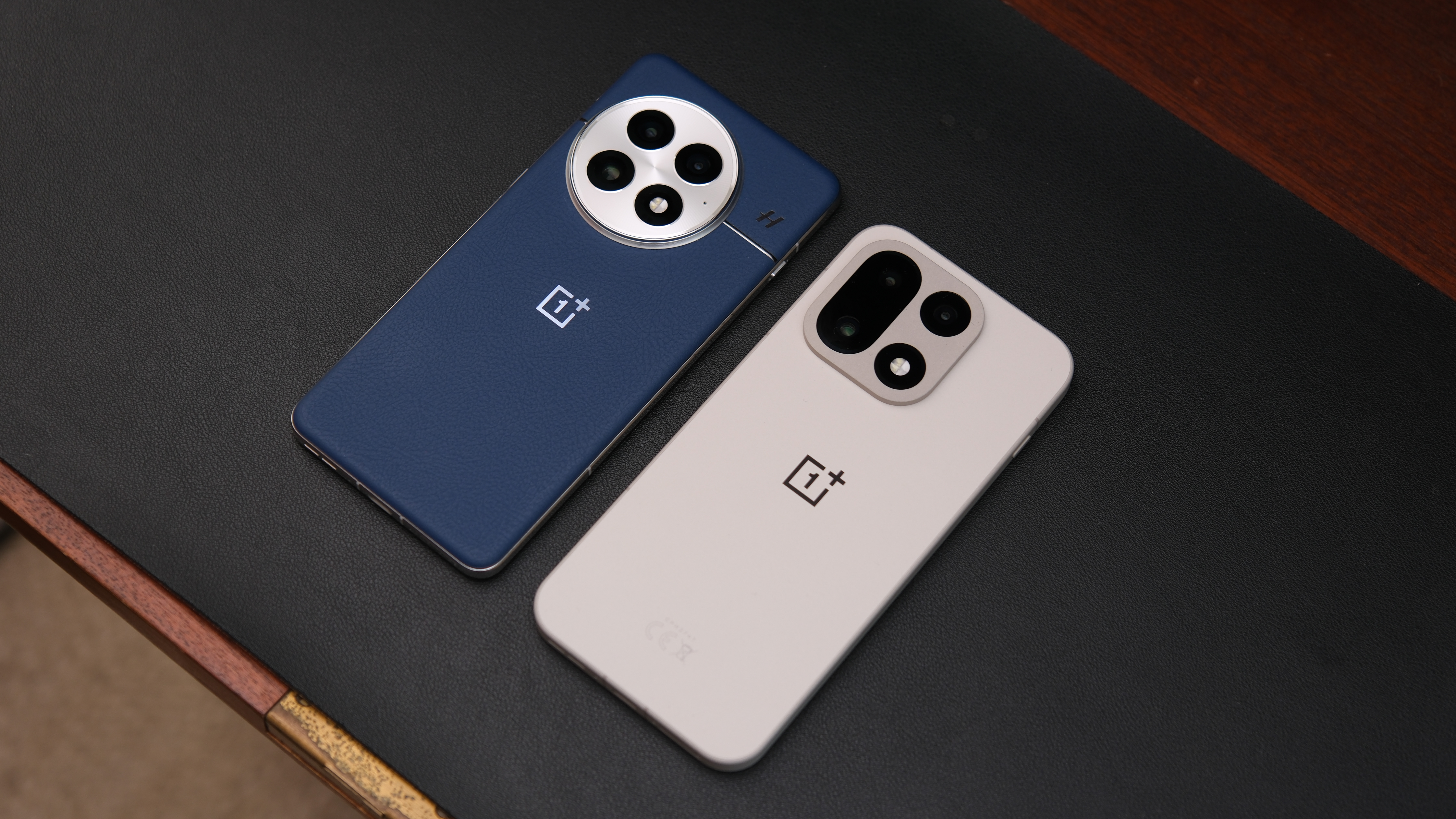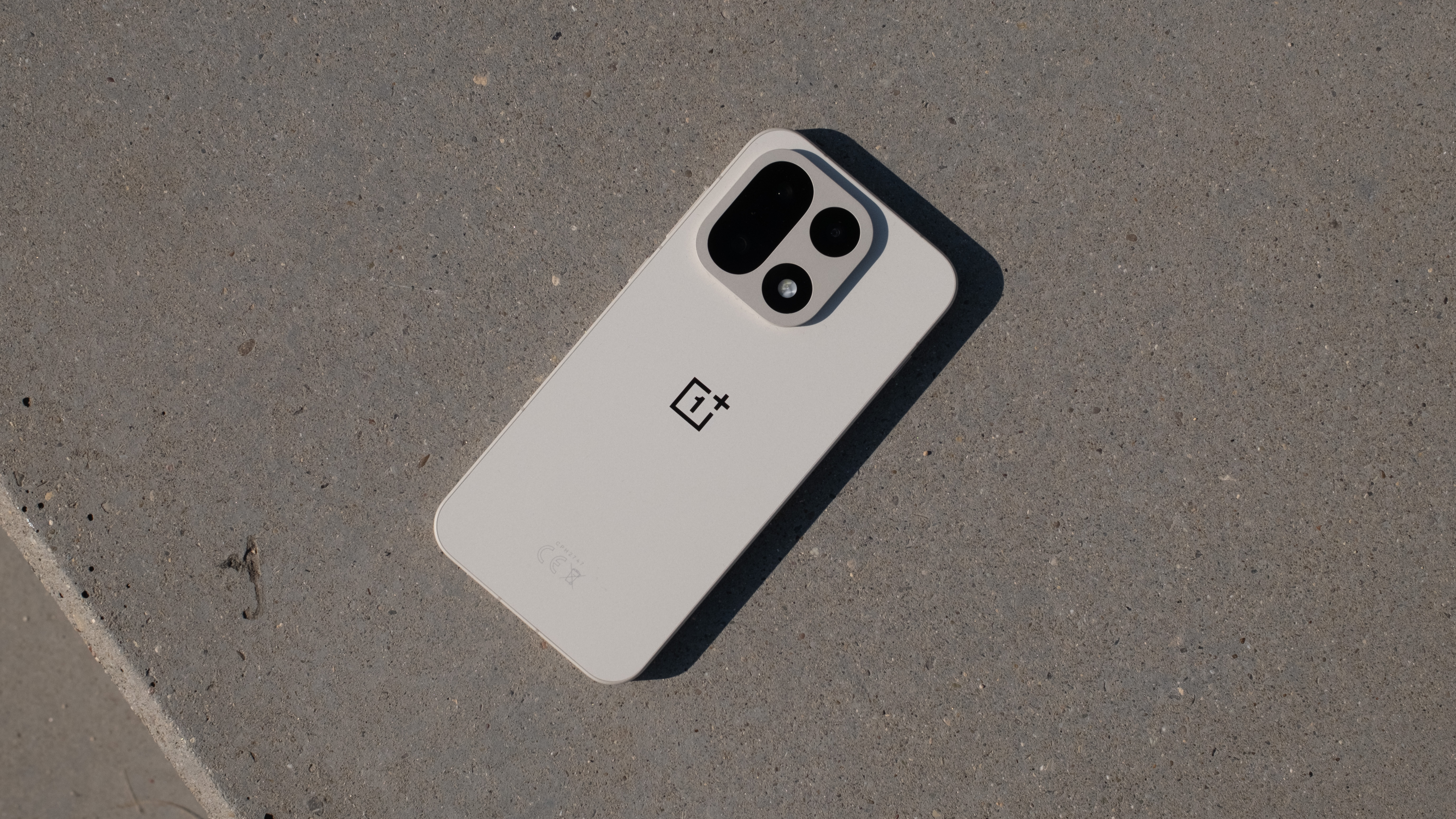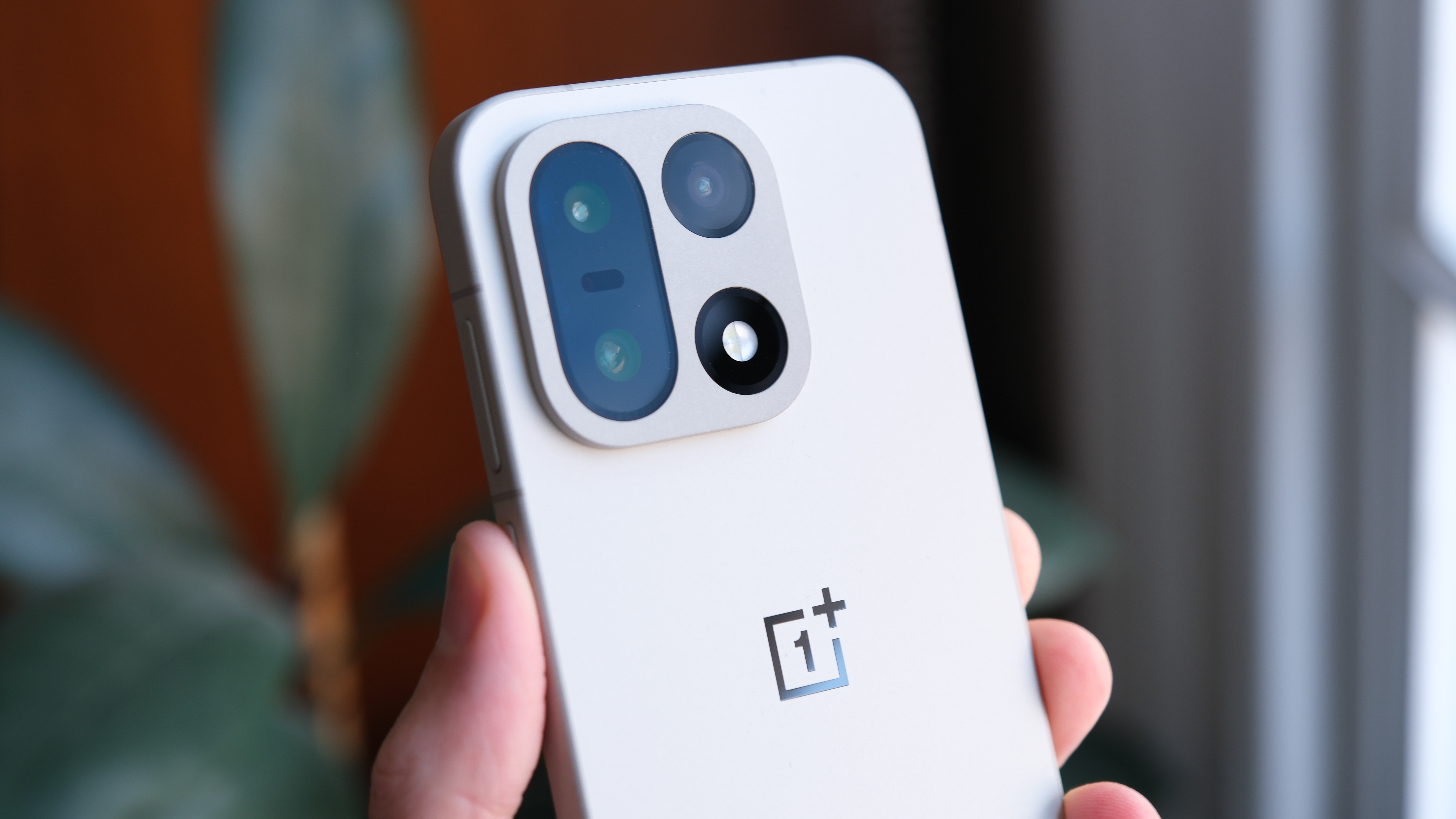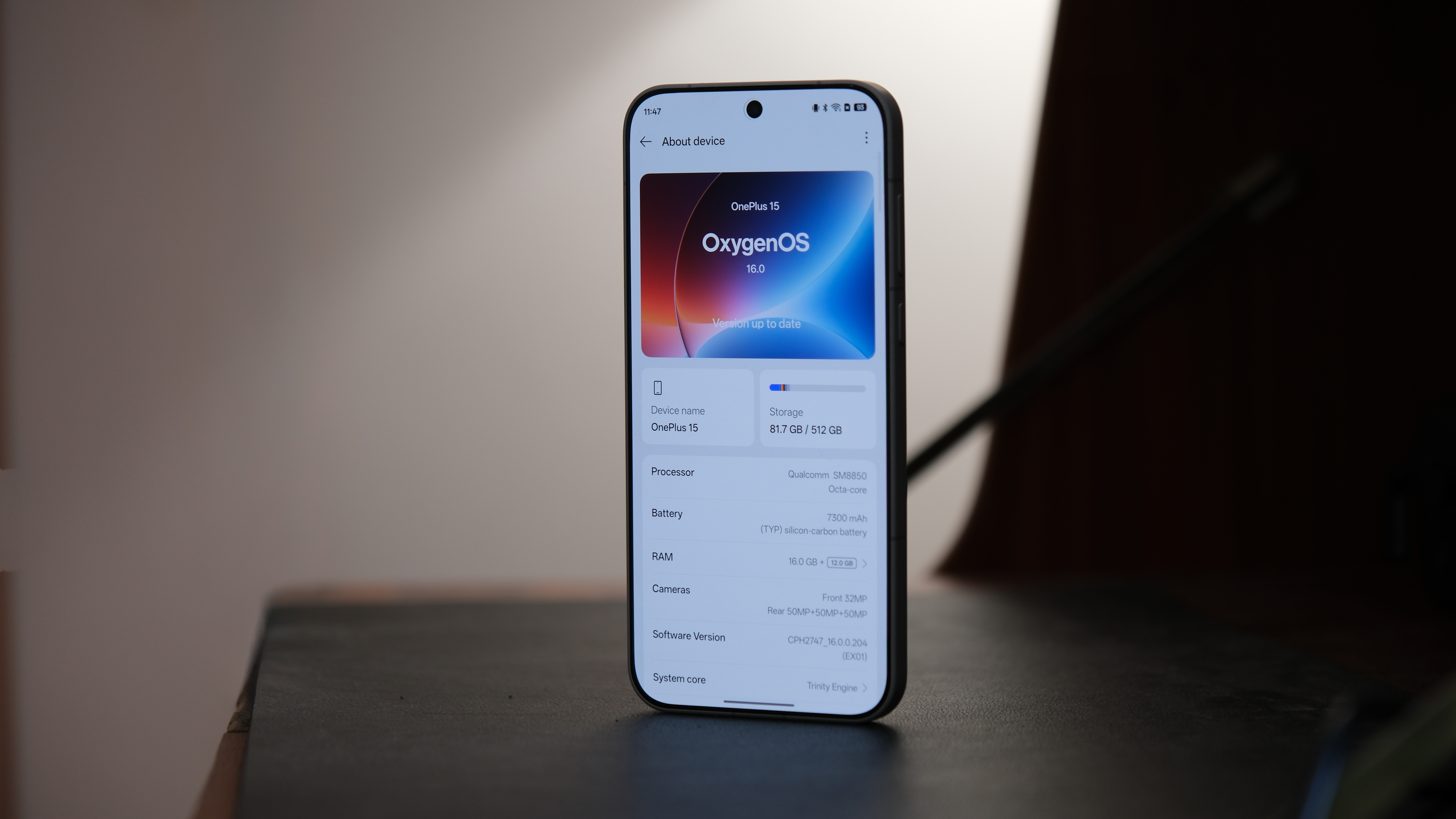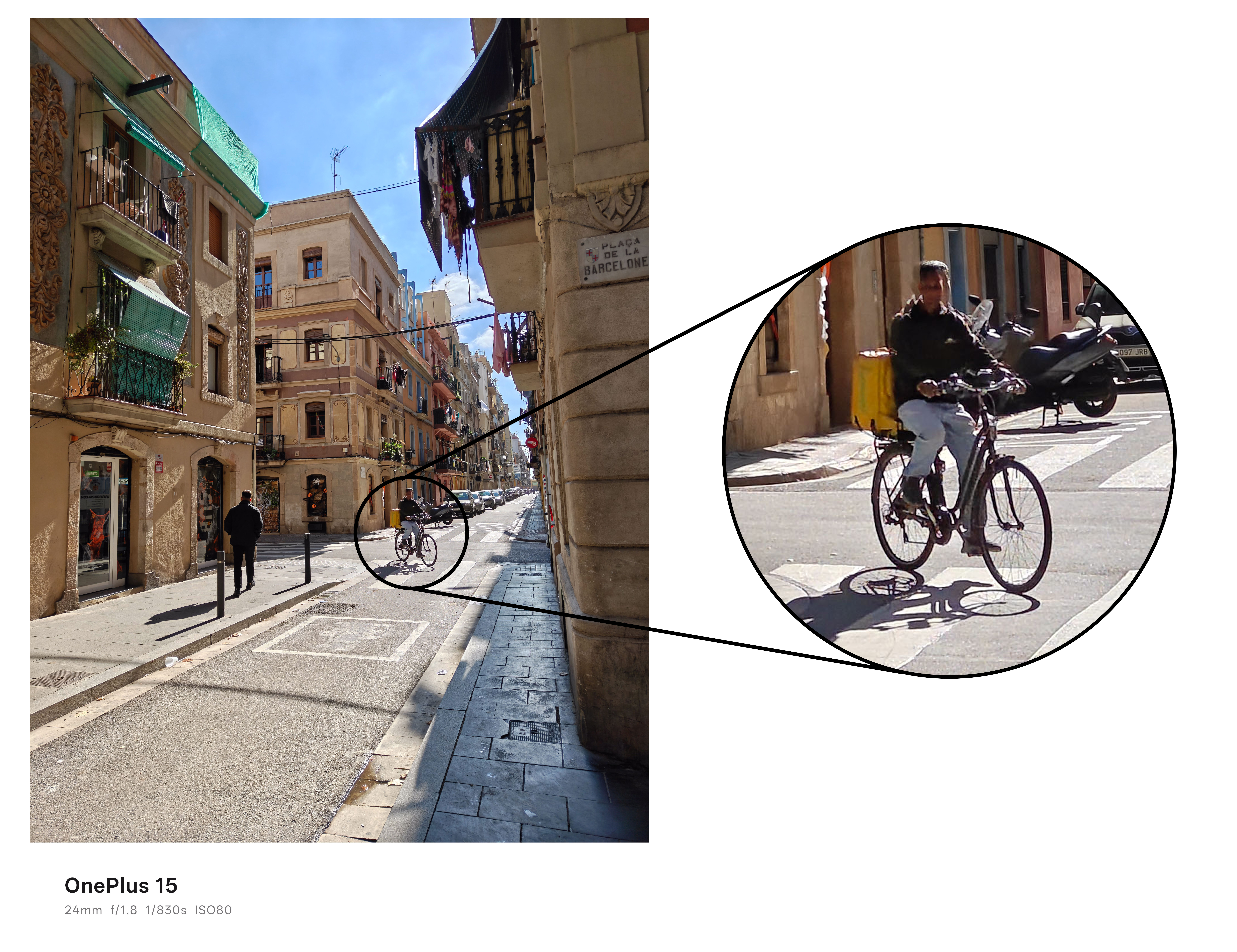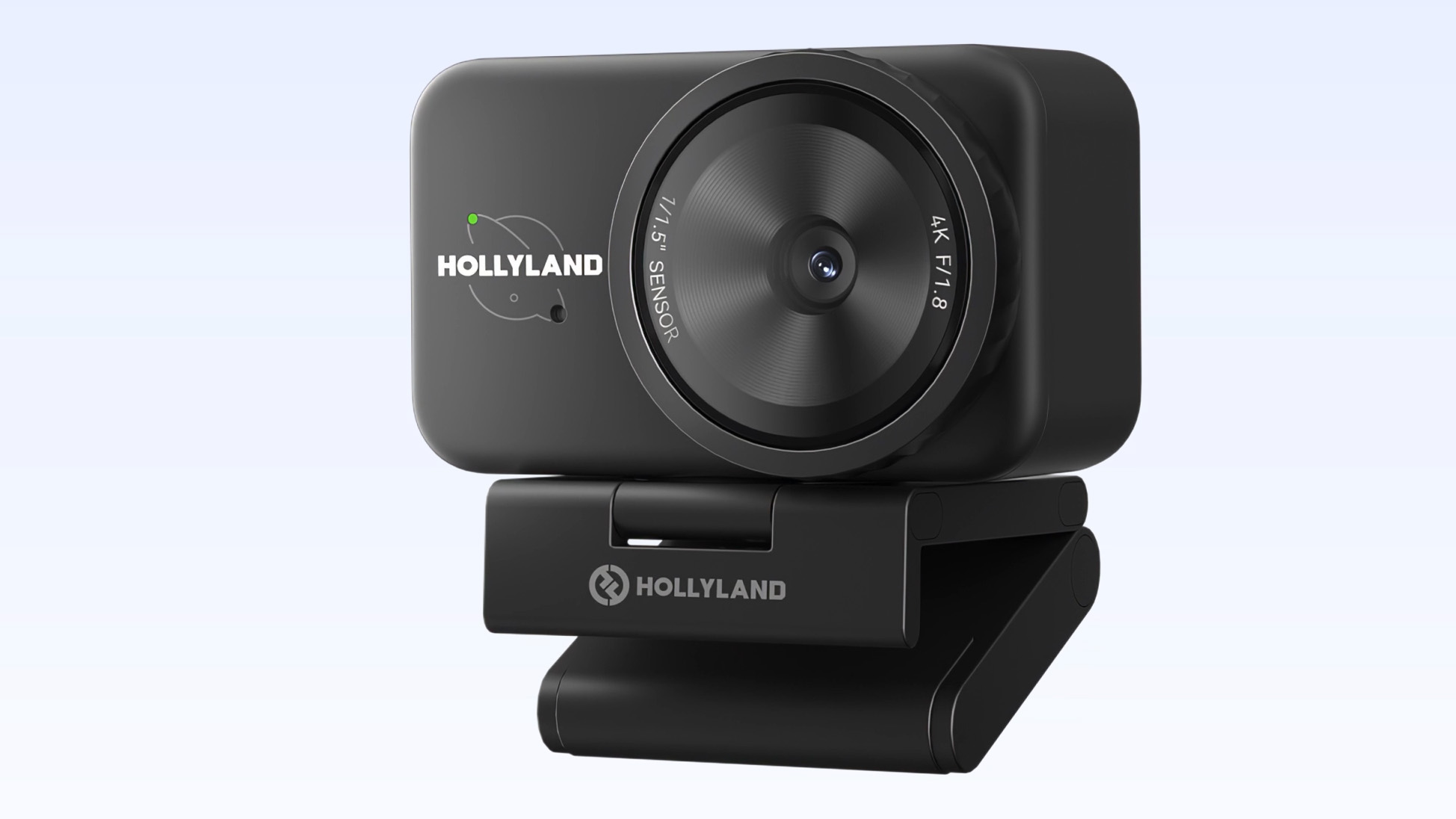Digital Camera World Verdict
The OnePlus 15 is an impressive phone – it delivers top-tier performance for gamers, outstanding battery life, a gorgeous display, and a refined design with some lovely color options. The cameras are solid, dependable, and capable of producing beautiful shots, but they don’t show the generational leap over to the previous model I was hoping for from the new DetailMax Engine.
Pros
- +
Powerful performance
- +
Battery life is excellent
- +
Great design and color options
- +
OxygenOS 16 is slick
Cons
- -
Marginal camera improvements
- -
Some HDR wobbles
Why you can trust Digital Camera World
With the OnePlus 15, the company is making its biggest gamble in years by saying goodbye to its long-running Hasselblad partnership and trusting entirely in its own new DetailMax Engine.
For a brand that’s spent several generations building its imaging identity around Hasselblad’s color science, this is a bold move – and one that immediately raises the question of whether OnePlus can deliver the same level of polish on its own.
DetailMax comes promising cleaner processing, higher quality, and better night shots, effectively redefining what “OnePlus photos” should look like. But in a market packed with aggressively competitive camera phones – has OnePlus made the right call here to ditch the Hasselblad name recognition and to go it alone?
Specifications
Processor | Qualcomm Snapdragon 8 Elite Gen 5 |
RAM / Storage | 16GB+512GB (Sand Storm & Ultra Violet) / 12GB+256GB (Infinite Black) |
Screen | 6.78 inches, 1272 x 2772 px, 1-165Hz, 1800 nits (HBM), Corning Gorilla Glass Victus 2 |
Wide Camera | 50MP, f/1.8, 24mm, 1/1.56", 1.0µm, OIS |
Ultrawide Camera | 50MP, f/2.0, 16mm, 1/2.88", 0.61µm |
Telephoto Camera | 50MP, f/2.8, 80mm (3.5x), 1/2.76", 0.64µm, OIS |
Front Camera | 32MP, f/2.4, 21mm, 1/2.74", 0.8µm, AF |
Video | 8K/30P, 4K/120/60/30P |
Battery | 7,300mAh |
Size | 161.4 x 76.7 x 8.1 mm (6.35 x 3.02 x 0.32 in) |
Weight | 211 g – 215 g |
Price
The OnePlus 15 comes in at $999 / £979 at launch for the Sand Storm and Ultra Violet colorways with 16GB RAM and 512GB storage, though there is an introductory offer that brings it down to £879 until December 12. There is also a 12GB+256GB version available for $899 / £849 in Infinite Black only. The Ultra Violet is also only available in limited quantities from Amazon and OnePlus directly.
For that price, you’re getting the latest Snapdragon processor and some of the strongest performance figures available right now that beat much more expensive phones. You also get huge battery life and a competitive camera system.
However, it’s worth noting that several rival brands are heavily discounting their previous-generation flagships, which might not be able to compete on power, but many of which still offer camera systems that can go toe-to-toe with, or even outperform, the OnePlus 15.
Design
The OnePlus 15 is a major design departure from the OnePlus 13. After last year's texture-focused designs, the 15 takes on a more sleek and sophisticated look, coming in more simple Infinite Black, Sand Storm, or Ultra Violet. The latter features a reflective edge around the frame, while the Sand Storm color debuts a new Micro-Arc Oxidation process to the frame, which should make it 3.4 times harder than an aluminum frame and 1.3 times as tough as a titanium frame. The black and violet versions feature a glass rear panel, while the Sand Storm opts for a fiberglass finish.
The best camera deals, reviews, product advice, and unmissable photography news, direct to your inbox!
I have tried all the finishes and they look great. I did like the textures and finishes of the OnePlus 13, they were "fun", but I think this generation is just more sophisticated with a lot sleeker and more refined design. I have the Sand Storm version, and it feels great in the hand, and I love the texture of the frame, which also extends to the camera island – although it does have a little bit of a recycled plastic aesthetic to it. My only small criticism is that the Sand Storm fiberglass feels a little hollow and doesn’t feel as solid as the glass version.
Perhaps the most noticeable design change is that the new model swaps its previously round camera island for a more compact square one, shifting it further up into the top corner. It's a very welcome redesign, moving the cameras into the top corner does move them even further away from roaming greasy fingers coating the lenses. For me, the OnePlus 13’s off-centre camera island was never the worst culprit for fingerprints, but now, using either hand, my index finger naturally rests on the bottom of the camera square, and actually improves grip.
I do really like this new design, but I also think we are running out of original ways to design a camera array. While it does now separate itself from the plethora of phones using a circular camera island, this new design feels heavily inspired by what we have seen for years with the iPhone, and also is near indistinguishable from sister brand Oppo and the Find X9 Pro. Coating the bump with the same material as the frame is a very nice touch and gives it some visual distinction.
Where with the previous model, the rear and screen had a slight taper into the frame, with the 15, these rounded sides have now been flattened out. The edge of the frame isn’t quite as drastic as some other brands, and it's very comfortable to hold. At 6.78 inches, it's about the perfect size for my hand, and thankfully, in daily use, I haven’t dropped the phone too many times. But if I did, the phone has Corning Gorilla Glass Victus 2, and should I also drop it into the sink, bath, or swimming pool, it's IP68 and IP69 rated – it can even survive high-powered jets, if that's a situation you ever find yourself in.
Around the edge, along the right-hand side, there is the usual power button – long press to activate Google Gemini – and the volume rocker, which can also double up as a quick access camera button. On the bottom lies the USB-C charging port, dual SIM slot, and speaker.
The most significant functional change is the removal of the Alert Slider; this has long been a staple of OnePlus devices, and I am sure many people will lament its replacement. However, the replacement, I think at least, is a much better solution – the Plus Key.
This is a single custom function button (think iPhone Action Button), which lets you choose from a range of functions for instantaneous access. The default way OnePlus wants you to use this button is to save screenshots into the new Mind Space app, which uses AI to analyse what you save and pull out helpful information. But you can set this to switch between do-not-disturb modes, turn on the flashlight, open the camera, or use it as an alert slider button.
Display
The screen is a 6.78-inch LPTO AMOLED display, with ProXDR for higher dynamic range. The OnePlus 15 tops out at 1800nits in high brightness mode, which I found plenty for viewing outdoors, even in direct Barcelona sunshine, where I was doing some of my testing. The screen can also dip down to 1nit by default for dark rooms where you might not want to disturb others. I'm not sure what situation this might be required, but if that's not enough, you can manually dim to 0.5nits by reducing the white point of the screen.
The screen has the latest eye care features with blue light filtering, reduced saturation in long sessions to reduce fatigue, and reminders to take breaks during long sessions, and has an Intelligent Eye Care 5.0 certificate from the screen boffins at TÜV Rheinland.
Where OnePlus opted for a slight curve on the edges of the display last time around, this time, the screen is perfectly flat, which, aesthetically, I do much prefer. It also makes viewing full-screen video or gaming more enjoyable without the top and bottom fractions bending around the screen and being a distraction.
The display resolution has technically dropped from a 2K resolution on the OnePlus 13 to 1.5K on the OnePlus 15, although, putting both models side by side, I really struggle to notice. Text online or in apps looks equally as crisp on both screens; the only noticeable difference I can see is that the contrast is slightly weaker on the new model, but we are nitpicking here. The OnePlus 15 screen is really very nice, and together with OxygenOS is one that makes me happy to look at every day.
Colors look fantastic. OxygenOS comes with a good degree of control over the colors on the device, with three default modes; standard for warmer tones, natural for a neutral white balance the most true-to-life colors, and vivid for bright colors. There is also the option to fine-tune the white balance of the screen in any of these modes.
I left the phone mostly in natural mode; the white point felt very accurate, contrast is good, and colors look very balanced for editing photos and video, with just the right amount of saturation. I think if you’re slightly less concerned with editing accuracy, then the vibrant mode adds a little more pop throughout the OS.
Camera Performance
The big news prior to the launch was OnePlus breaking ranks with Hasselblad. For the 15, OnePlus is going it on its own with its new DetailMax image engine. With DetailMax, OnePlus is promising a higher level of computational photography than what we have seen before in its phones – meaning cleaner processing, more detail, and better night shots. After using the phone for a month, I’m impressed, but not totally convinced it's better than what came before.
Images from the OnePlus 15 are very good; you can get some really nice shots out of these cameras, but they just aren’t really a big generational improvement on the OnePlus 13 that I was hoping the new engine might bring.
The reason might lie with OnePlus opting for smaller sensors on all three of its cameras this year, with DetailMax left to make up for the shortfall. All three sensors this year are again 50MP units, but the sensors themselves differ in size. The main sensor has gone from a 1/1.43" sensor with an f/1.6 aperture in the OnePlus 13 to a smaller 1/1.56" sensor and f/1.8 aperture in the OnePlus 15, while the telephoto has seen a significant size decrease from a 1/1.95" sensor to a 1/2.76" sensor.
Again, I am nitpicking a little, and image quality from all three cameras, in decent light, is very good. There is a pleasing sharpness and clarity to photos without an overaggressive artificial sharpening, causing unwanted artifacts. Colors are also very true to life; despite the split from Hasselblad, the tone of images remains very similar to the previous generation, which you won’t hear any complaints about from me.
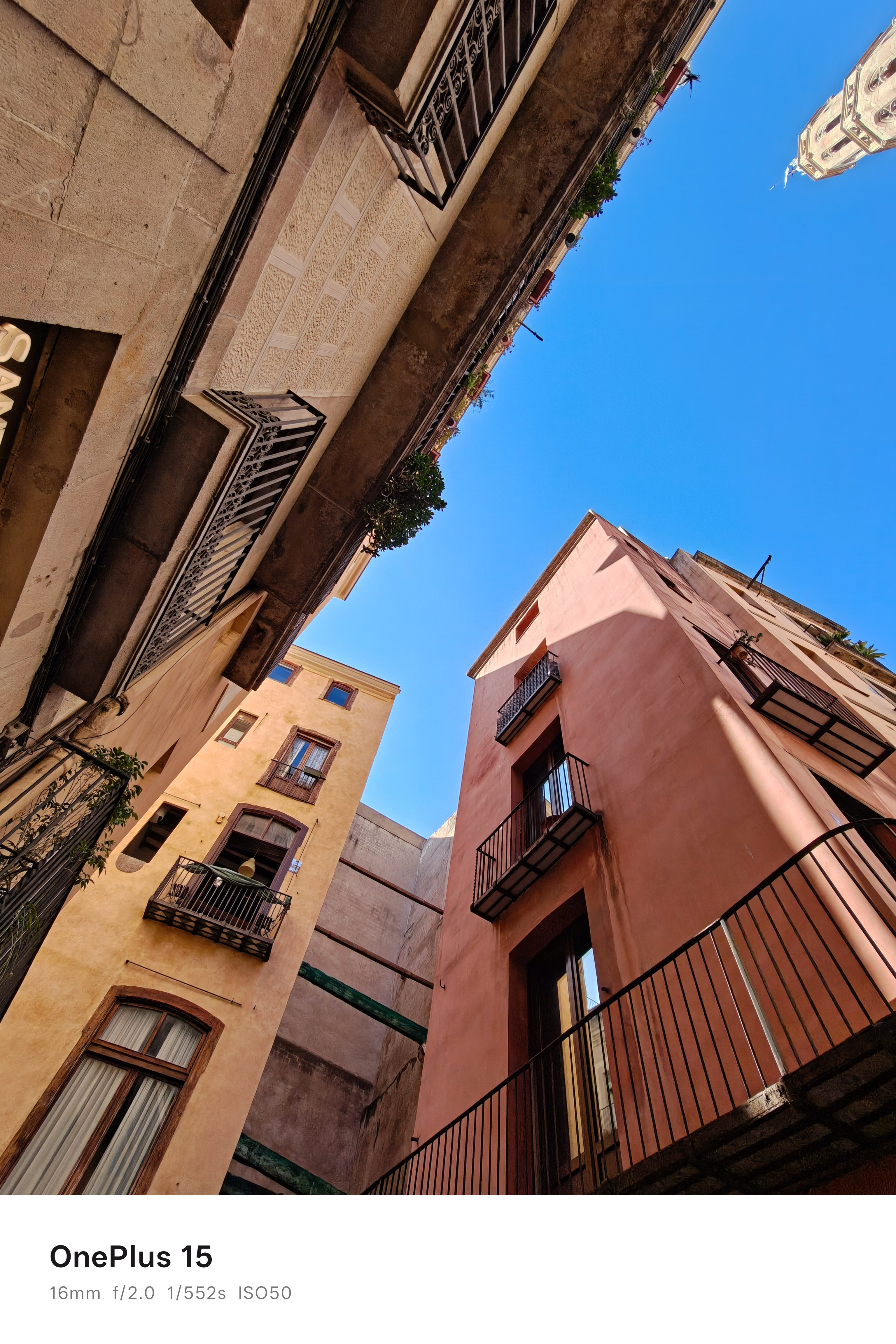
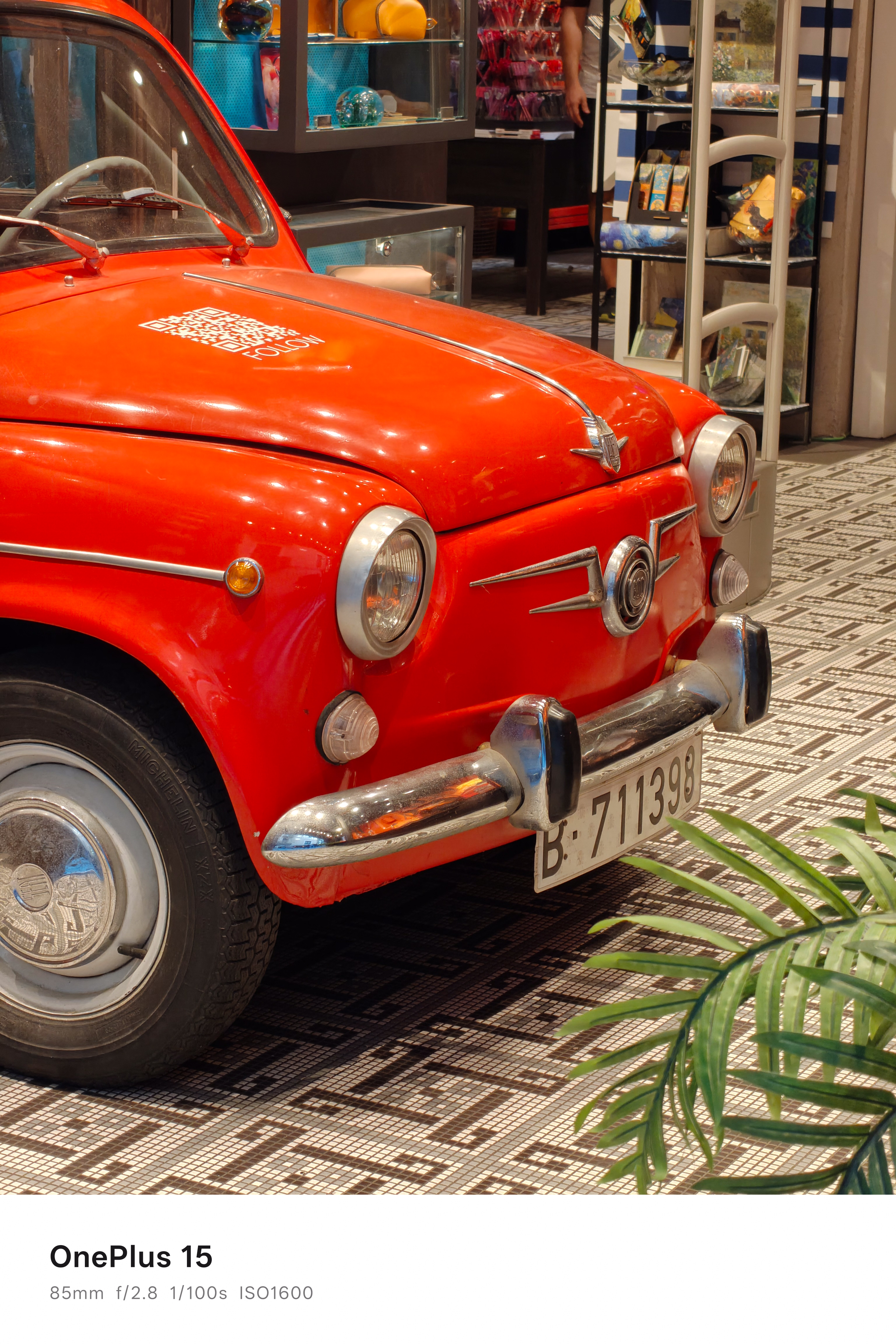

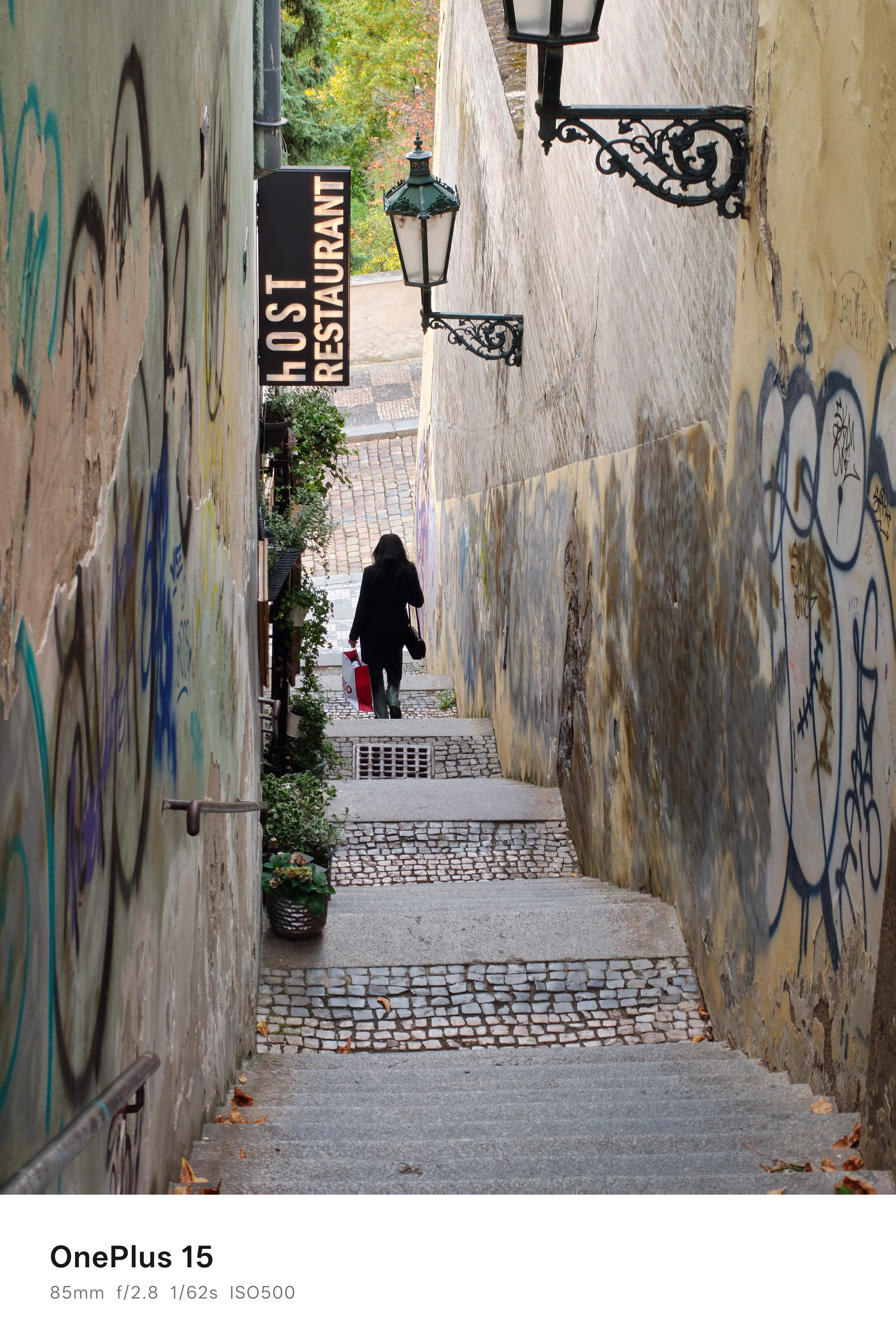


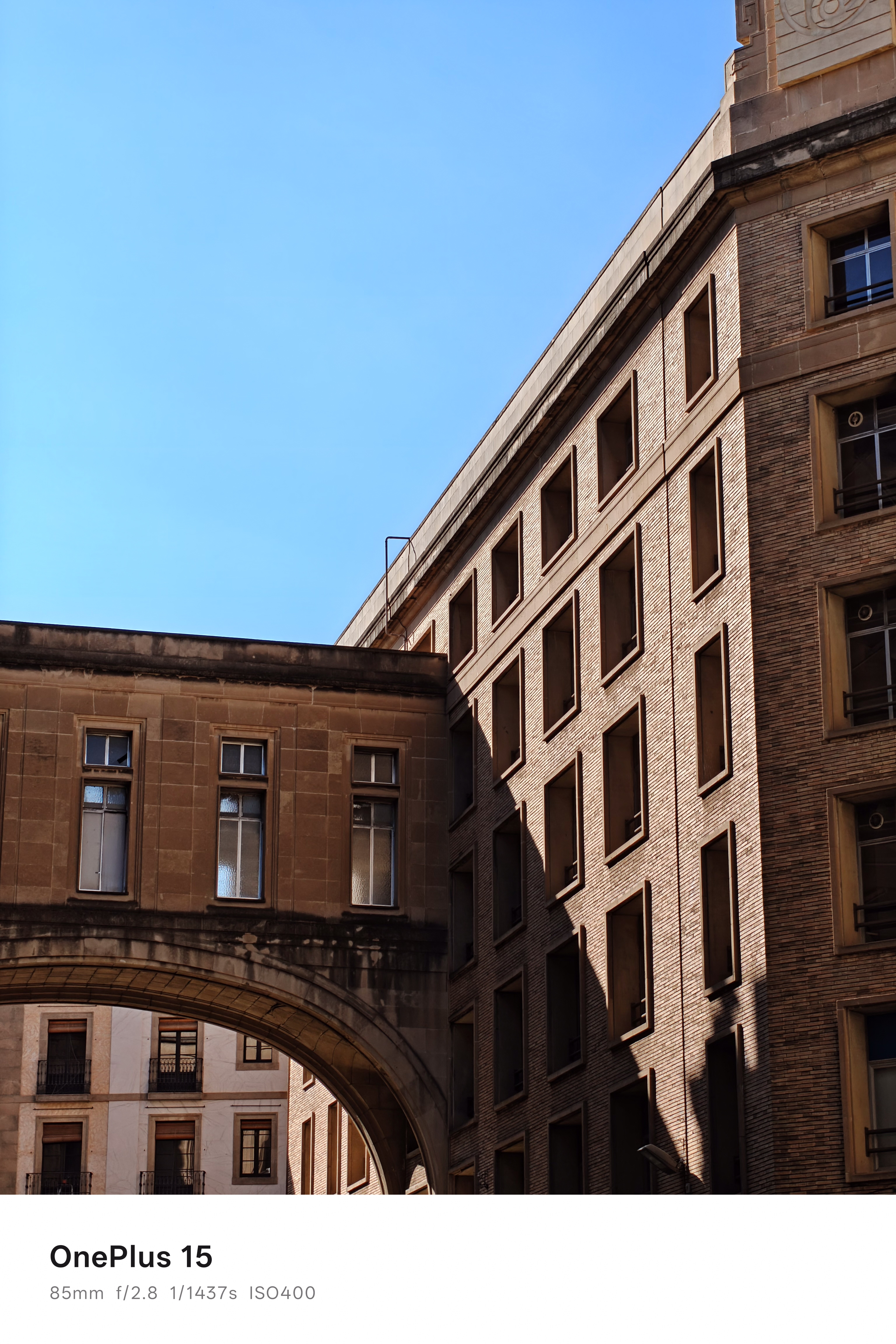


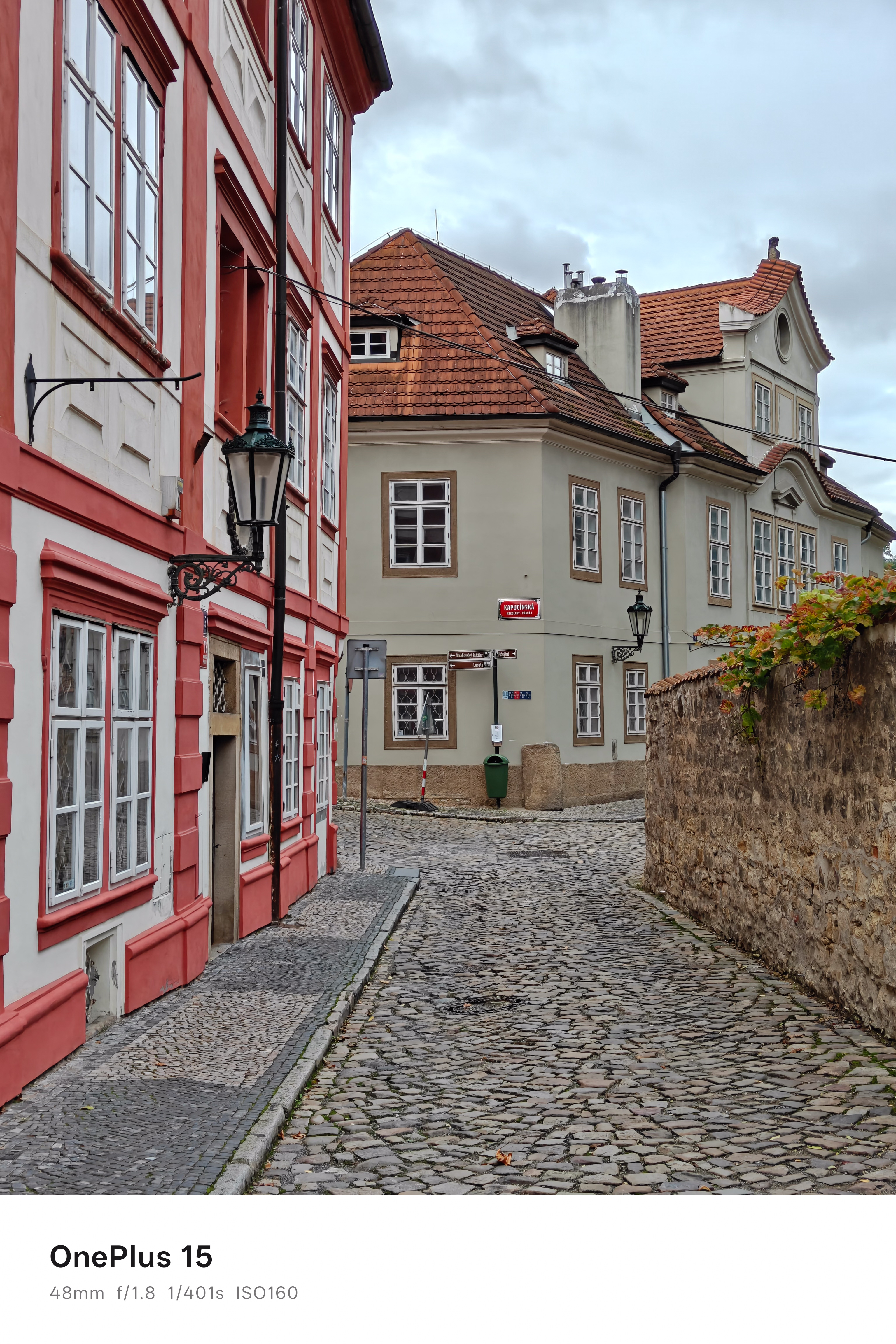


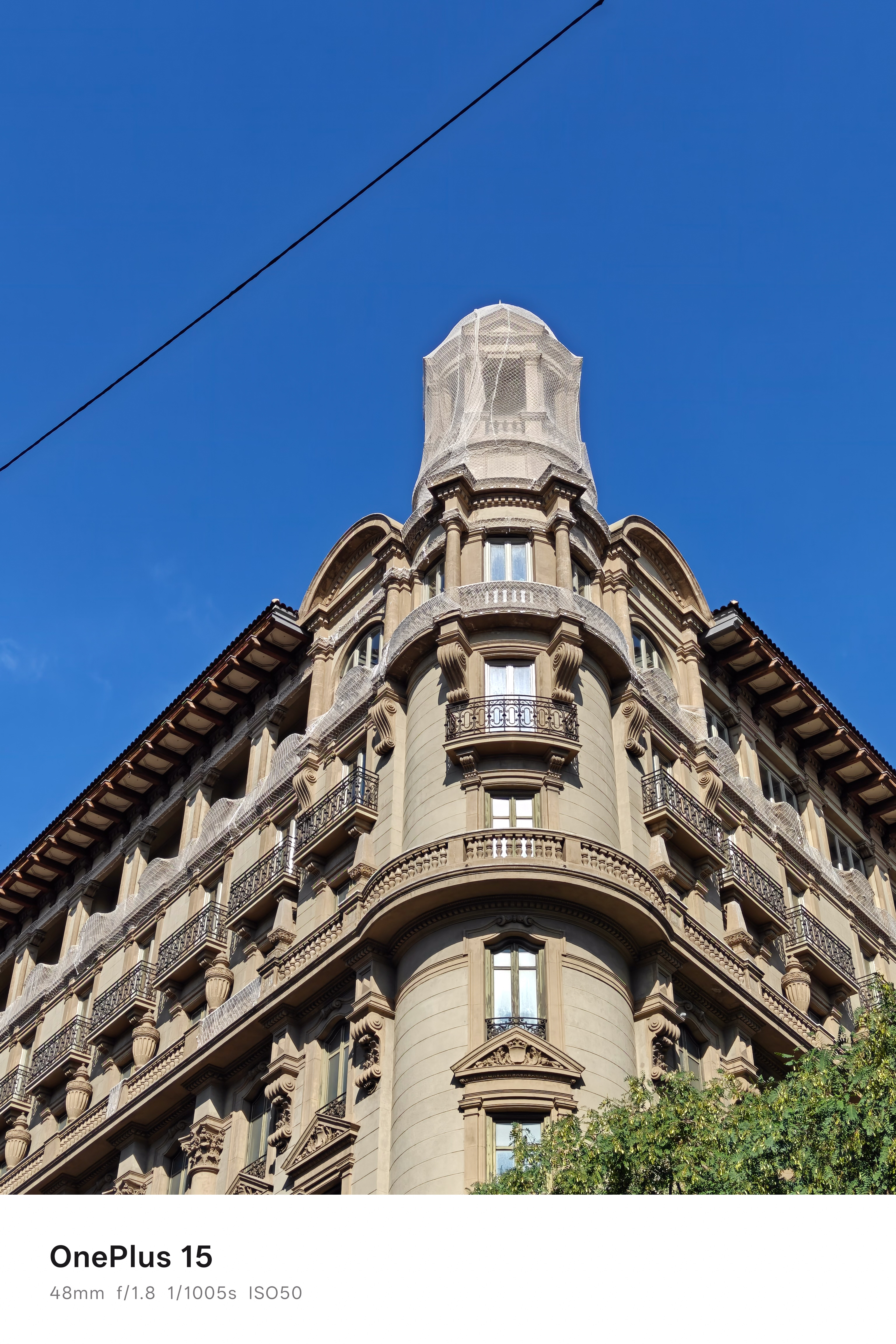
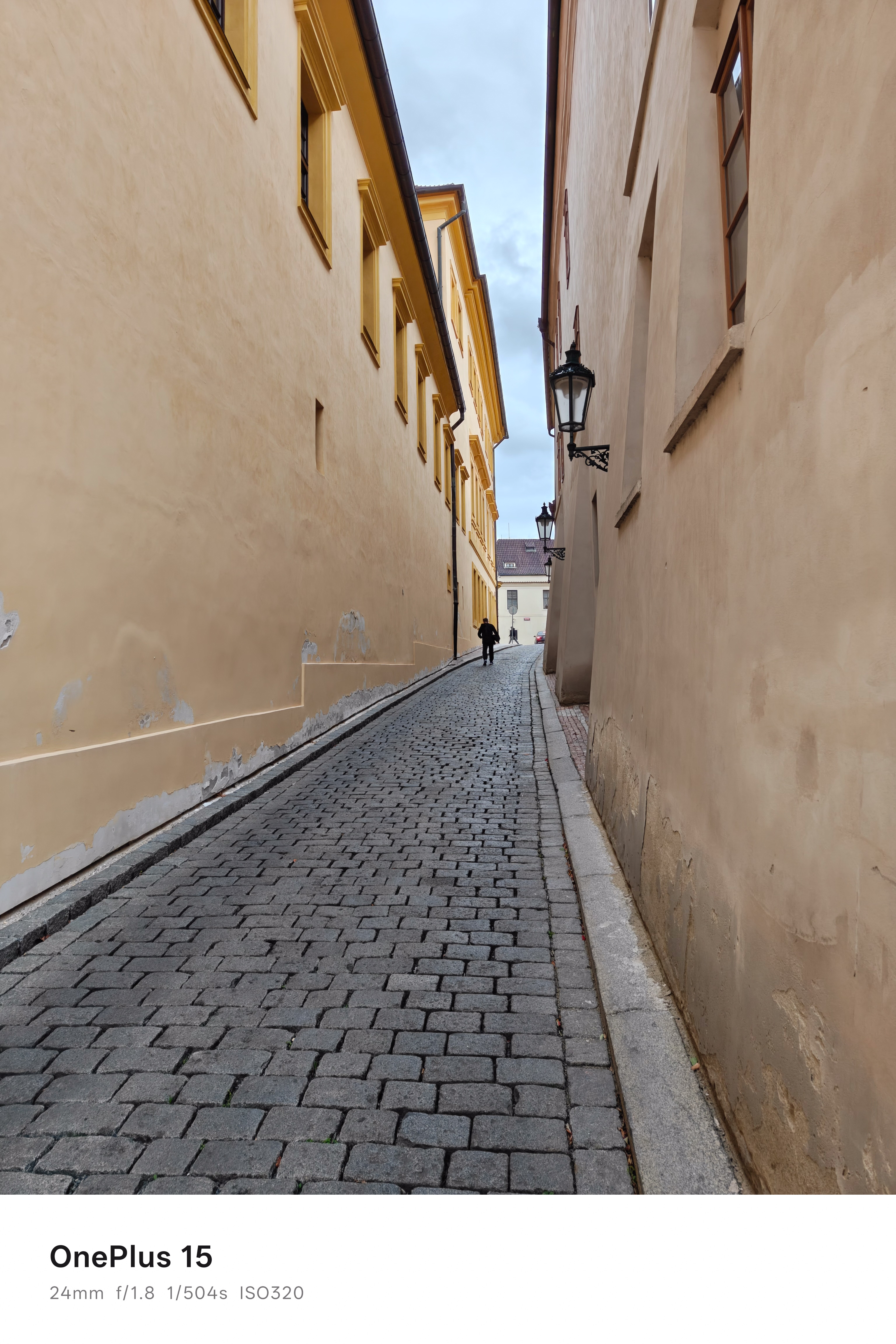

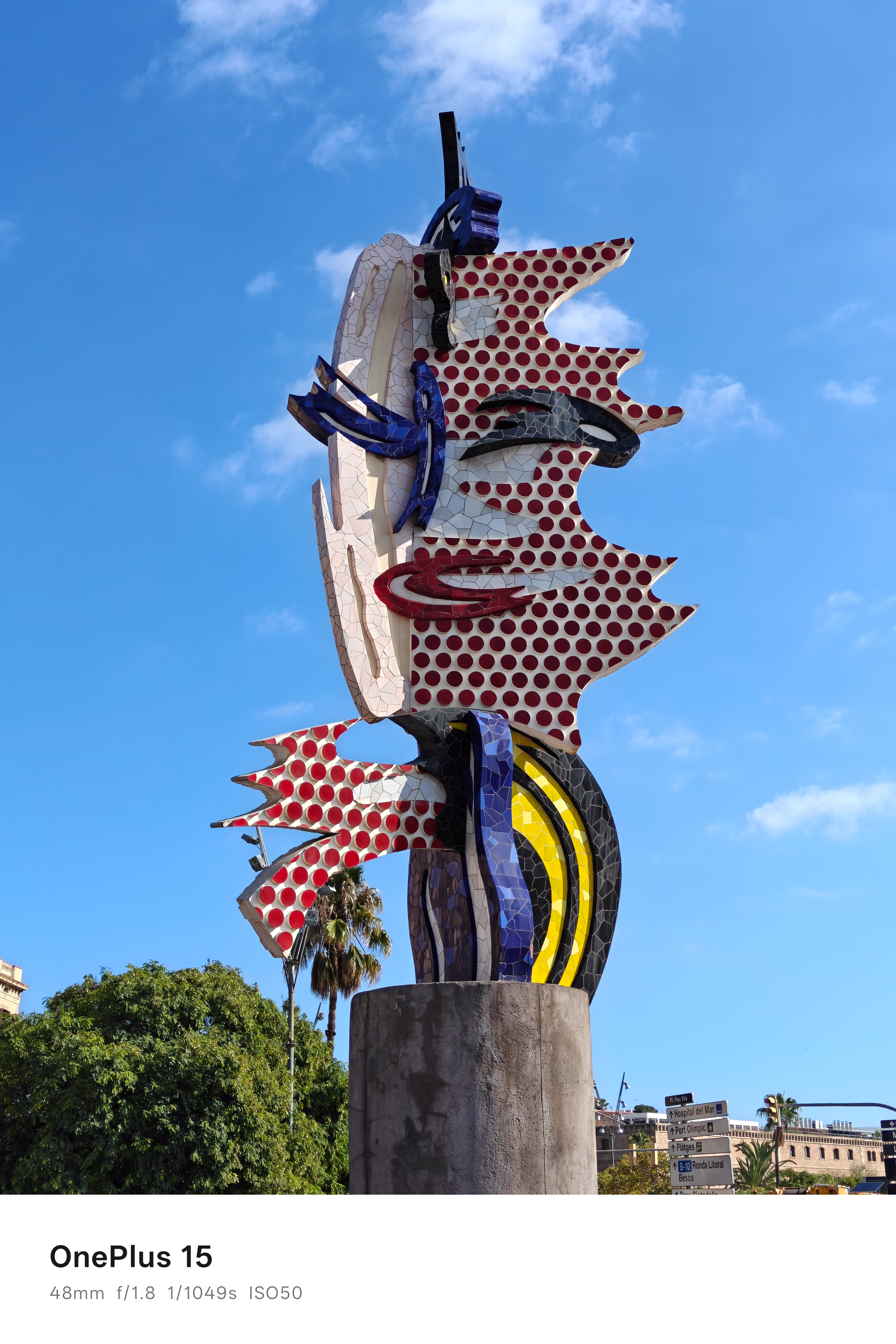
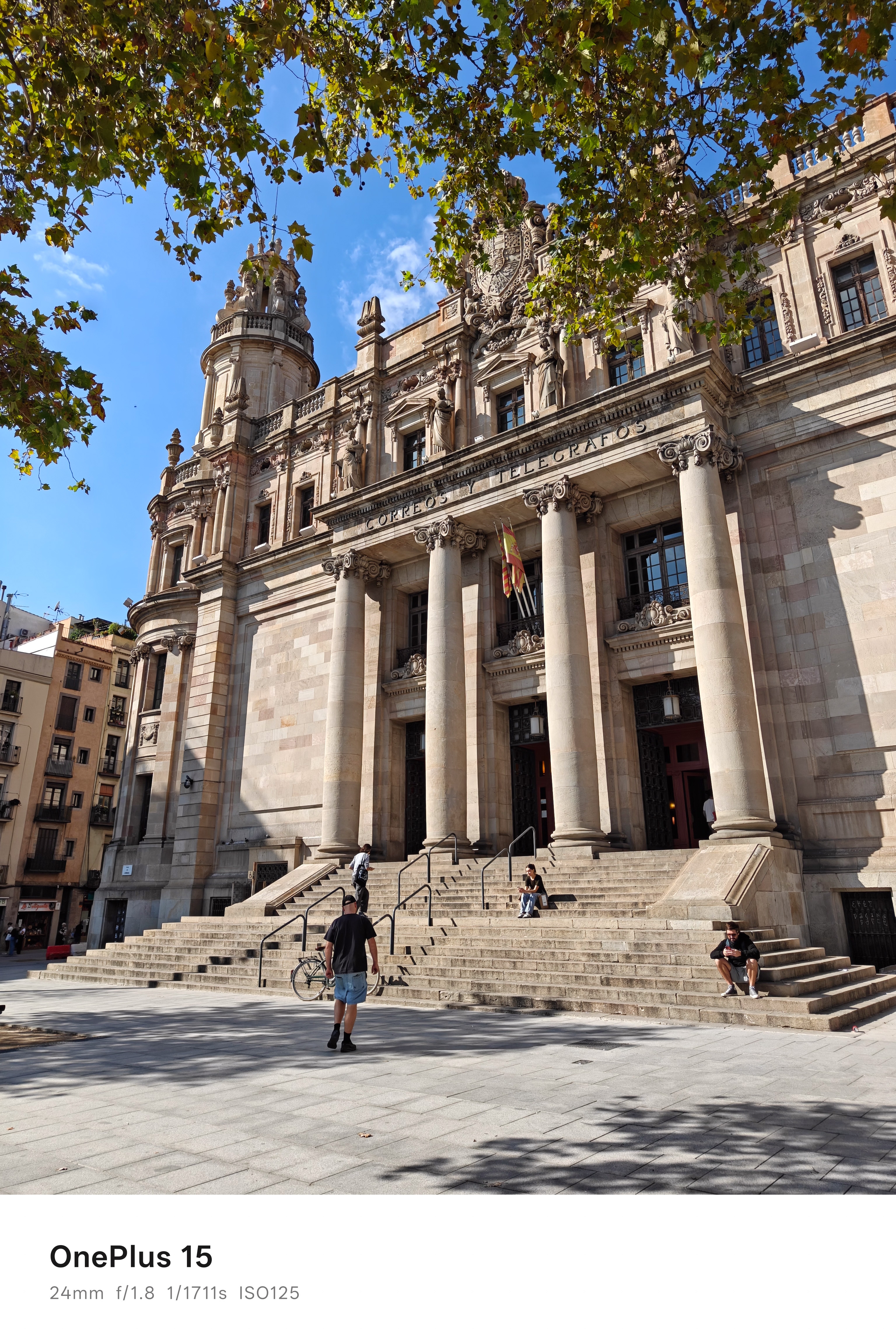
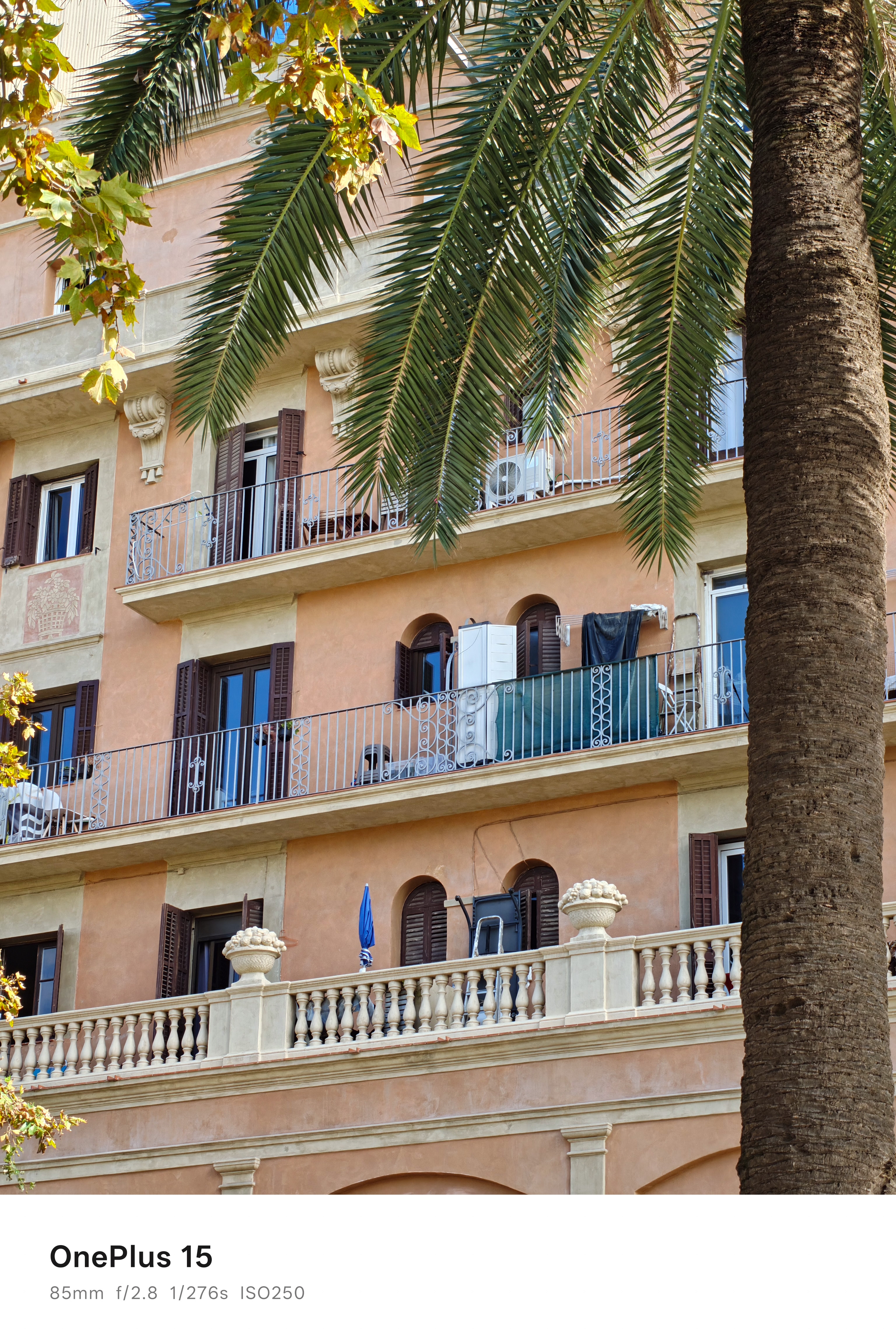

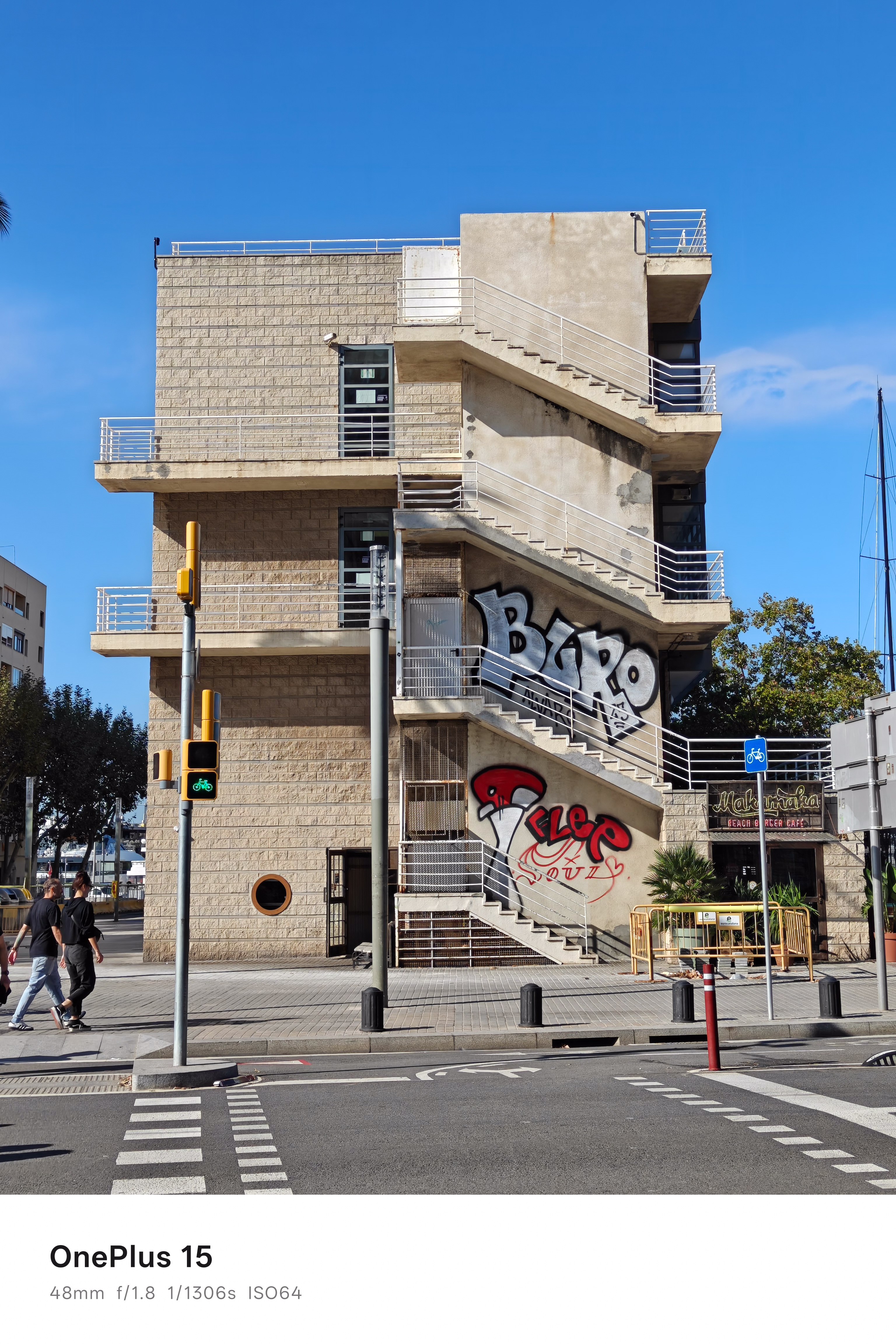


The main camera and telephoto camera are both excellent performers, and I am really struggling to separate them to determine which is my favorite. The ultrawide camera is also pretty good, although it is behind the other two lenses, just as the sharpness can’t quite match up as you start to pinch into images, with details quickly becoming squiggly. All three lenses also do a good job of maintaining color and white balance consistency as you zoom through the focal range, with only occasional wobbles with harsh changes to light and shadows. As a triple-camera system, though, it's solid.
The HDR can, on occasion, be a little heavy-handed. I shot a lot of the narrow streets of Barcelona, with bright blue skies and shadowy alleyways, but images too often came out looking a little flat. I wish the phone would keep a bit more contrast in the image, as certain HDR images just look too unnatural. There is also a minor glitch I noticed a few times where fast-moving subjects would just be blurred by the HDR processing – see below.
At night, images are good so long as you and your subject are static, as any movement seems to introduce blur. I walked around the city of Prague at night trying to get shots, but even the OIS in the main lens struggled to compensate for my hand shake. This is most likely those smaller sensors coming back to bite. In successful captures, colors and contrast at night are good. The main wide lens is the one to go for here, although I got some good shots with the telephoto in dim light – I would just avoid the ultrawide when the light drops, as my night shots just became muddy oil paintings.





Superzoom is a bit of a weak spot for the OnePlus 15 compared to other rival devices, which have pushed out ahead. You can zoom up to 170mm (7x) with lossless quality, with the camera using in-sensor cropping. After that, the phone will use AI to clean up images all the way up to a whopping 2914mm (120x) zoom.
Quality up to 170mm is fantastic, I wouldn’t hesitate to use the sensor crop, but beyond that, quality drops off quite quickly. The AI makes images look quite unnatural, with overly smooth textures, some strange artifacts, and gives subjects an ethereal glow – it's fine to use if necessary, but normally I wouldn’t be sharing any of these images.
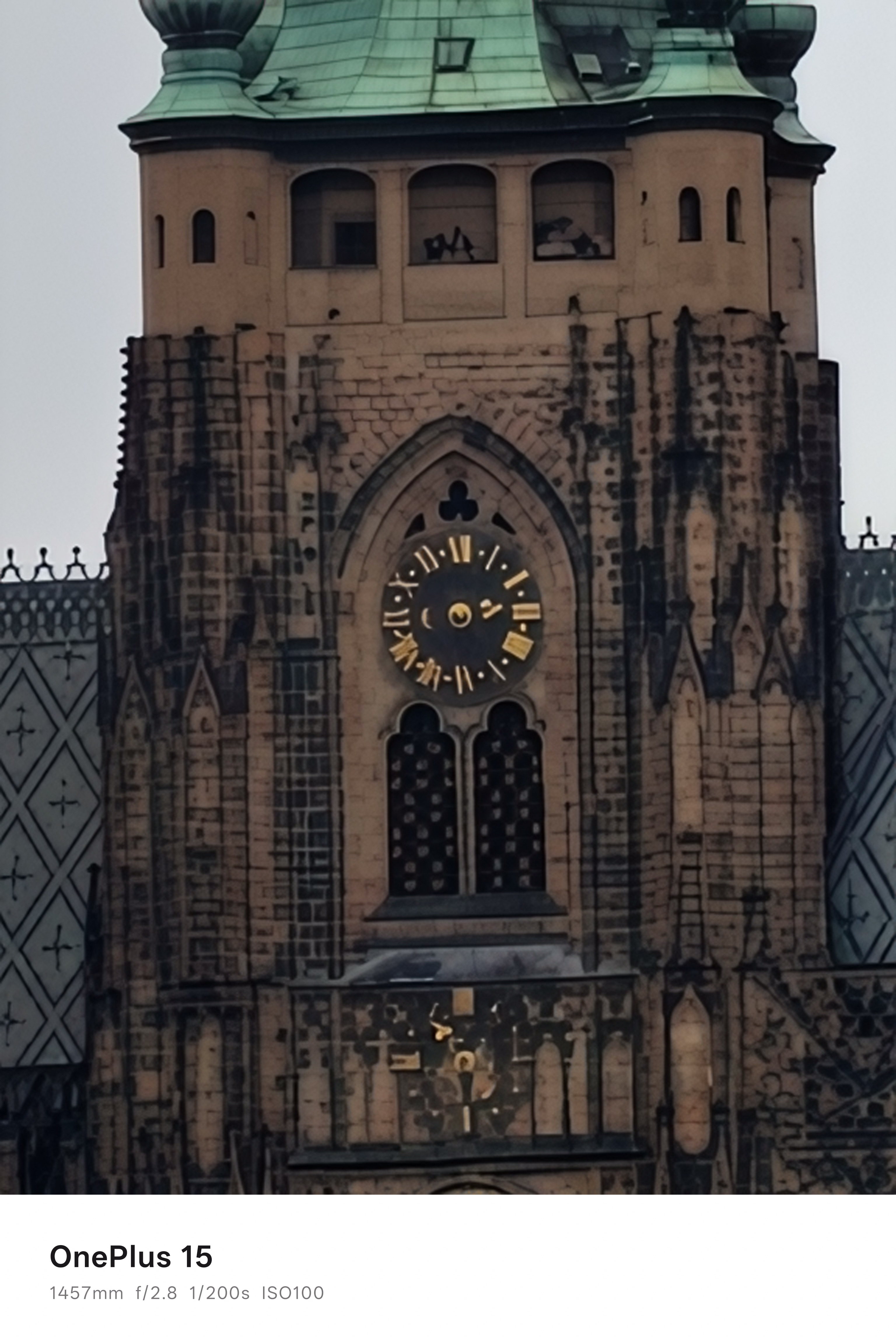


The video performance on the phone is impressive, footage is clean and vibrant with good dynamic range, and it maintains solid stabilization with decent focus tracking. The standout feature this year is the addition of 4K recording at 120 frames per second, which allows for smooth cinematic slow-mo clips.
Phone Performance
The OnePlus 15 comes with the latest Snapdragon 8 Elite Gen 5 processor, which OnePlus claims offers a 20% performance gain and a 23% improvement in graphics performance, while making significant power efficiency improvements. OnePlus is also claiming the world’s fastest phone RAM – LPDDR5X Ultra+ – which runs at 10667Mbps in the 16GB variant.
In practice, all these numbers mean the OnePlus 15 is very fast. This is one of the fastest phones I have tested, and as you can see in the benchmarking, it is a good improvement on the previous OnePlus 13 and the previous gen of Snapdragon chips.
| Row 0 - Cell 0 | OnePlus 15 (Snapdragon 8 Elite Gen 5) | OnePlus 13 (Snapdragon 8 Elite Gen 4) | Samsung Galaxy S25 Ultra (Snapdragon 8 Elite Gen 4) | Oppo Find X9 Pro (Mediatek Dimensity 9500) |
GeekBench 6 CPU (Single Core) | 3527 | 2945 | 2853 | 3077 |
GeekBench 6 CPU (Multi Core) | 10848 | 8950 | 9448 | 8929 |
GeekBench 6 GPU (OpenCL) | 23949 | 17871 | 17929 | 23680 |
Day-to-day, it's quick; you won’t have any issues with bottlenecks or slow apps. For more intensive photo and video editing, the phone runs apps like Lightroom and Capcut seamlessly. I have been editing a several-gigabyte Capcut video made up of multiple clips with transitions, animations, and text, and the OnePlus 15 isn’t struggling to scrub through the 4K30p footage in the preview.
There are a growing number of AI editing features in the OnePlus Photos app. We have seen some of these before, like AI Eraser, AI Recompose, and AI Reflection Eraser, but these have both improved in speed and quality, and there are some new options too, including AI Relight, which can shift the light around on a harshly lit portrait and even out the light to look more natural. On the whole, these tools are very impressive, and a few have grown to be pretty invaluable to how I shoot now. Before, I'd be hesitant to shoot through windows, but I can be pretty confident that the AI Reflection Remover has my back.
One of the most impressive specs of the new phone lies with its whopping 165Hz refresh rate. For the uninitiated, refresh rates determine how quickly phones can update the image on their screen; faster refresh rates make for smooth scrolling – but the real advantage is in gaming, where refresh rates can combine with frame rates for super smooth gameplay.
The OnePlus 15 is very smooth, both when it comes to moving around the OS and jumping in and out of apps or scrubbing through video; there is zero lag in animations, and gaming feels fast and responsive.
As a camera reviewer, I am not the authority on gaming, but I tested the phone with several different games, including frame rate heavy hitters like Call of Duty Mobile, Dead Cells, and Real Racing 3, and the OnePlus 15 did really well in maintaining a 145+ frame rate throughout the sessions without getting overly hot.
Using the OP Gaming Core overlay, you can also monitor your frame rate and battery life, with there are three different modes for getting the most out of the graphics, or prolonging the battery, alongside a wealth of other settings.
Battery life is standout; the OnePlus 15 just keeps going and going. There is a 7,300mAh battery inside, which uses the latest in silicon-carbon technology, allowing more juice to be stored inside a smaller footprint. The OnePlus 15 can also take advantage of SuperVOOC charging, with speeds up to 120W wired charging or 50W wireless charging with compatible chargers.
I am easily getting a full day of power on a particularly intensive day using the phone – that's scrolling the web, streaming video, taking photos and video, and writing in Docs and Gmail – I have been finishing the day with around 30% battery, not using any power saving modes. On quieter days when I am working from home and just replying to the occasional WhatsApp, this stretches to around two days.
Gaming will be a different story; the increased battery will allow you to use that high refresh rate for longer gaming sessions, but it will take its toll on the battery health faster. However, the OnePlus 15 does have an option for bypassing the battery when gaming to protect its longevity – you can plug into a wall socket or power bank and keep gaming at full power. In normal use, however, OnePlus quotes that the battery will maintain 80% capacity after 4 years.
Verdict
The OnePlus 15 is a beast; it's a big performance upgrade from the last model, and it flies through demanding apps. Performance improvements perhaps won’t be felt quite so keenly by photographers, but if you also love to game on your phone, then you need the OnePlus 15. Battery life is outstanding, the 7,300mAh cell comfortably lasts a full day of heavy use and often stretches into a second on lighter ones, and combined with ultra-fast SuperVOOC charging, it never seems to run out of steam. Design-wise, the new matte finish, colors, and materials are sleek; the leatherette and texture of the previous generation are more fun, but I prefer this look, and the flat sides and display feel more modern and well-balanced in the hand.
The camera system is solid. The triple 50MP setup remains versatile and reliable, capturing sharp, color-accurate images. The new DetailMax Engine promises smarter processing and improved low-light performance, and while photos look clean and natural, the jump in quality over last year’s model is subtle at best. The main and telephoto lenses impress in good light, but the smaller sensors struggle a little at night, and HDR can sometimes flatten dynamic scenes. Overall, the OnePlus 15’s cameras are strong performers – just not the breakthrough I hoped for
At its price, though, the OnePlus 15 still offers tremendous value. You’re getting flagship performance, excellent battery life, and a camera system that rivals phones that cost far more – although price reductions on rivals’ older Pro and Ultra models bring them closer to the OnePlus’ launch price.
Features | New design language looks much cleaner with great color choices. The decision to move the cameras into a square island looks a little familiar, but it makes a big difference for holding the phone without getting fingerprints on the lenses. 4.5 |
Design | Solid camera system with great sharpness, colors, and consistency between the lenses – although there is not the generational leap I hoped to see from the hyped-up new DetailMax image engine. 4 |
Performance | Blazingly fast, you might not feel the full benefits as a photographer, but if you also like to game, then the OnePlus 15 has you covered. Battery life is also outstanding, with over a day’s power, you won’t be rushing to the charger every evening. 5 |
Value | For the latest processing power, long-running battery, and solid camera system – it's great value. Undercuts the launch prices of flagships from rival brands, but older rival Pro and Ultra phones are starting to see discounts. 4.5 |
Overall | ★★★★☆ |
Alternatives
We are a few months on from its release now, so the Google Pixel 10 Pro and 10 Pro XL are already seeing discounts that take them to around the price of the OnePlus 15. Google’s phones can’t match the power of the OnePlus 15 for gamers, but if you are mainly interested in a phone for its cameras, then Google’s devices offer some of the cleanest and most reliable images from an Android phone.
<p><strong>Read the full <a href="https://www.digitalcameraworld.com/tech/android-phones/google-pixel-10-pro-and-pro-xl-review"><strong>Google Pixel 10 Pro & 10 Pro XL reviewIf you are bored with Samsung/Google and looking for something a little different, then check out the Nothing Phone (3). It's Nothing’s first proper flagship phone, and for a first attempt, it gets a lot right. Beautifully designed, it is unique and eye-catching, as is the operating system. The cameras are not quite up to other flagships, but are solid performers, and you can add your own LUTs to them to really make your shots your own.
<p><strong>Read the full <a href="https://www.digitalcameraworld.com/tech/android-phones/nothing-phone-3-review"><strong>Nothing Phone (3) review
Gareth is a photographer based in London, working as a freelance photographer and videographer for the past several years, having the privilege to shoot for some household names. With work focusing on fashion, portrait and lifestyle content creation, he has developed a range of skills covering everything from editorial shoots to social media videos. Outside of work, he has a personal passion for travel and nature photography, with a devotion to sustainability and environmental causes.
You must confirm your public display name before commenting
Please logout and then login again, you will then be prompted to enter your display name.
